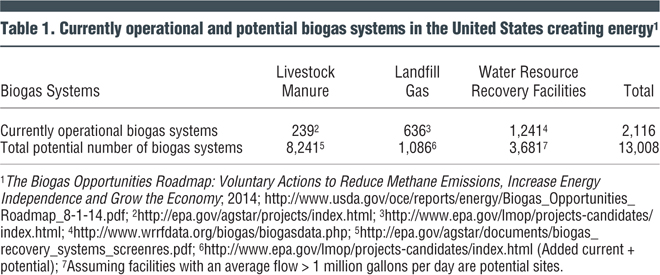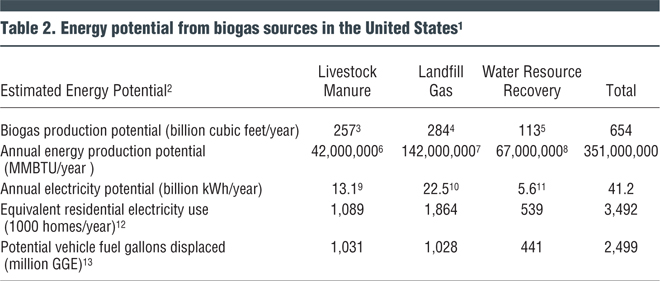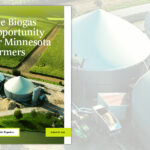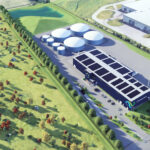Roadmap identifies existing federal programs and funding that can increase use of biogas systems to reduce methane emissions and generate energy and fuels.
Patrick Serfass
BioCycle September 2014
The Biogas Opportunities Roadmap: Voluntary Actions to Reduce Methane Emissions, Increase Energy Independence and Grow the Economy,” was jointly released August 1, 2014 by the U.S. Department of Agriculture (USDA), the Department of Energy (DOE) and the Environmental Protection Agency (EPA) with support from the White House. The Roadmap features a list of existing federal programs and existing funding that could support growth of the U.S. biogas industry but are either not currently utilized or are underutilized. The three agencies emphasize the Roadmap is a voluntary strategy, i.e., it does not propose new regulations or new requirements. In addition to USDA, DOE and EPA, representatives from the dairy and biogas industries participated in its preparation.
In the Climate Action Plan, released in June 2013, President Obama directed his Administration to develop a comprehensive, interagency strategy to reduce methane emissions and promote cutting-edge technologies that help farmers, energy companies, and communities convert methane into a renewable energy source and grow America’s biogas energy industry. In March 2014, the White House released a Climate Action Plan Strategy to Reduce Methane Emissions to help provide greater incentives to spur creation of more cost-effective biogas energy technologies. This included preparing the Biogas Roadmap.
In addition to identifying existing but underutilized federal biogas-related programs, the Roadmap outlines strategies to overcome barriers limiting further expansion and development of a robust biogas industry in the U.S. It reflects several commitments by USDA, DOE and EPA to continue working with industry stakeholders to identify steps to reduce emissions and expand the biogas industry, including through development of new technologies. The Roadmap also supports the U.S. dairy industry’s voluntary 2008 goal to reduce its greenhouse gas emissions by 25 percent by 2020. This goal was a driver behind a partnership forged between the dairy industry and USDA in December 2009 and renewed in May 2013. As part of the 2013 renewal, the dairy industry also requested that USDA create a voluntary biogas roadmap to support this goal.
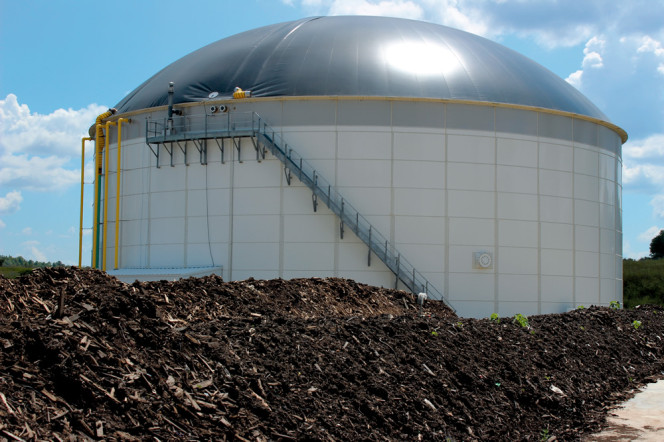
A lack of consolidated financial and technical data for the biogas industry made it difficult to tabulate the economic and environmental benefits from anaerobic digesters not located on farms or at wastewater treatment plants.
Why Biogas?
Biogas systems have the capability to achieve both direct methane reductions by treatment of organic waste streams (e.g., manure, food waste) as well as indirect reduction by replacement of fossil fuels used for traditional energy generation and vehicle fuel. For example, the 239 livestock biogas systems currently operating in the U.S. provide enough renewable energy to power the equivalent of almost 70,000 average American homes. They reduce methane emissions by the equivalent of approximately 2 million metric tons of carbon dioxide annually. An additional 8,000 livestock operations (Table 1) are candidates to support livestock digester projects. If the full potential was realized, a cost-effective biogas industry could produce enough energy to power about one million American homes.
In addition to the farm digesters, more than 1,900 biogas systems are currently operating at landfills and water resource recovery facilities. (The Roadmap uses the term, “water resource recovery facilities” instead of wastewater treatment plants, reflecting changes in language driven by the wastewater industry’s acknowledgement of the resources it has in the biosolids removed from the water it processes.) The Roadmap found that with the proper support, almost 3,000 additional biogas systems in these two sectors could be deployed in the U.S. (Table 1).
A lack of consolidated financial and technical data for the biogas industry limited the federal agencies’ ability to estimate the market potential for full deployment of biogas systems. However, based on a survey with the industry and project developers reflecting current deployment, building those approximately 11,000 potential systems would result in an estimated $33 billion in capital deployment for construction activity, which would result in approximately 275,000 short-term construction jobs and 18,000 permanent jobs. Plus, these biogas systems could produce enough energy to power more than 3 million American homes and reduce methane emissions equivalent to 4 to 54 million metric tons of greenhouse gas emissions in 2030, the annual emissions of between 800,000 and 11 million passenger vehicles.
These numbers do not reflect the full market impact of biogas, which would also include energy and product sales, and sales of existing and potential environmental credits. Nor do they reflect the market opportunity in building new food waste biogas systems or adding food waste to livestock manure or wastewater biogas systems. USDA estimates that in 2010, approximately 133 billion pounds of food from U.S. retail food stores, restaurants and homes went uneaten. This represents 31 percent of the 430 billion pounds of the available food supply at the retail and consumer levels in 2010, with retail-level losses accounting for 10 percent (43 billion pounds) and consumer-level losses for 21 percent (90 billion pounds) of the available food supply.
Overall, the organic resources available to feed biogas systems in the United States are vast; the primary feedstock sources are livestock manure, food waste, landfill gas, water resource recovery facility biosolids, and food production residuals. If captured and managed in a biogas system, these resources could yield substantial energy and biobased product resources while providing environmentally sound management.
Biogas systems can enhance resilient communities by reducing methane emissions, improving water quality, producing a local source of renewable heat, electricity and fuel, and strengthening the local economy by reducing energy costs and generating revenue. They can also play a vital role in helping communities adapt and become more resilient to the effects of climate change. For example, the distributed nature of the biogas systems can increase the reliability of critical services — food, energy, waste management, wastewater treatment and transportation — during and after disasters. Biogas systems are potentially less vulnerable to grid failures that can halt vital services. For example, a wastewater treatment or food production plant that is powered by onsite biogas could continue operation during a grid-wide power outage. Biogas system products could also be used to produce a renewable transportation fuel for routine use or should traditional sources be temporarily cut off.
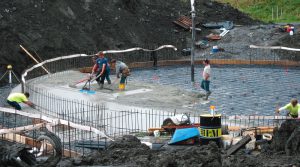
The Biogas Opportunities Roadmap cited the current number of farm-based digesters (239), but noted that 8,000 additional livestock operations in the U.S. are candidates to support digester facilities.
Today’s clean water (i.e., wastewater) agencies are increasingly considering how they can improve environmental performance, benefit their communities and improve their financial picture. The Water Resources Utility of the Future initiative encourages water utility leaders who are using innovative technologies and cutting-edge practices to focus on resource recovery including energy production, water reuse, green infrastructure or watershed-based approaches instead of simple disposal of wastewater sludges or biosolids.
Primary Barriers
The Biogas Opportunities Roadmap identified six primary barriers toward achieving a robust U.S. biogas industry. The barriers include:
Lack of awareness of biogas benefits: Investors, policy makers, and the public could benefit from gaining a deeper understanding of the value of investing in biogas systems and a biogas industry in the U.S. Greater public support for the adoption of biogas systems could result in more opportunity for biogas development.
Unpredictable biogas market conditions: Market unpredictability is a prime barrier toward greater investment in biogas systems. Unpredictability arises from multiple factors, including uncertainty and inconsistency in state and national energy policy, which restricts access to financial markets. Further market uncertainty arises when consumers perceive inconsistency in the quality or quantity of biogas systems or in the safety and quality of solid and liquid end products from digesters.
Lack of market maturity: Underdeveloped markets for GHG reduction benefits pose a significant barrier toward biogas systems adoption. Additionally, immature markets for nonenergy products — such as nutrient-rich soil amendments, pelletized and pumpable fertilizers and feedstock for plastics — also reduce incentives to invest. There also is a need for a classification system for the use of digested solid and liquid residuals to encourage consumer confidence in product safety and consistency (see BioCycle East Coast Preconference Workshop sidebar).
Lack of full valuation: It is difficult for small generators to interconnect to the grid and to receive a fair market price for the electricity that reflects the full environmental value provided. Overall, the high project costs without financial recognition of the nonenergy services create a barrier toward widespread investment in biogas systems.
Inconsistencies across federal, state and local governments: Fragmentation of existing resources, regulatory authorities, and jurisdictions at the federal, state and local levels affect biogas system implementation. In addition, fragmented efforts within and among federal agencies to inform stakeholders, state and tribal governments — and the public — of the regulations, policies, practices and potential funding of biogas systems create more barriers.
Lack of technical and applied research & development: The U.S. currently lacks adequate environmental, technical and economic performance data related to biogas system production of energy, coproducts, GHG and other emissions reductions, and water quality benefits. Consolidation of this data could help market analysis and underwriting. There is also a need for more advanced research in the U.S. related to renewable energy and biogas coproduct benefits, including a better understanding of barriers by sector that prevent full utilization of anaerobic digester capacity and digestion of feedstocks.
Government Actions
Because biogas has proven to be a reliable resource for energy but is underdeveloped in the U.S., the Biogas Opportunities Roadmap identifies government actions that can help encourage technology deployment. Specific federal actions described in the Roadmap are focused on four areas: Promoting biogas utilization through existing agency programs; Fostering investment in biogas systems; Strengthening markets for biogas systems and system products; and Improving communication and coordination. Action steps identified within in each area include:
Promoting biogas utilization through existing agency programs: Strengthen and leverage existing USDA, DOE and EPA programs to enhance utilization of biogas systems in the U.S. Within EPA, for example, programs include AgSTAR, Combined Heat and Power Partnership and Sustainable Materials Management (see AgSTAR partnership sidebar).
In terms of research and new technology, the Roadmap states that USDA’s Agricultural Research Service and National Institute of Food and Agriculture will leverage over $10 million in research funding for anaerobic digesters to improve research for nutrient recovery, particularly nitrogen and phosphorus, from biodigester effluent and solids and investigate agronomic and economic viability of using captured nutrients as commercial fertilizers and soil amendments. In addition, DOE will further integrate biogas and biosolids systems into the Bioenergy Technologies Office program and develop a research plan to implement the recommendations of the Biomass Research & Development Technical Advisory Committee to accelerate development of biobased products from biogas systems.
Fostering investment in biogas systems: USDA will lead efforts to improve the analysis of industry financial and technical data, evaluate current loan and grant programs, and review federal procurement guidelines for opportunities to broaden the financing options available for biogas systems. USDA and DOE will review applicable current loan and grant programs to enhance financing options available for biogas systems. To further the development and deployment of biogas systems, within 90 days (of release of the Roadmap), the USDA and partners will review federal procurement guidelines for alternative fuel use and renewable energy procurement to ensure that products of biogas systems are eligible for and promoted by applicable government procurement programs. The Roadmap also suggests assessment of the efficacy of developing NAICS (North American Industry Classification Standard) codes for biogas systems to track industry performance.
Strengthening markets for biogas systems and system products: USDA, DOE and EPA will review opportunities to overcome barriers to integrating biogas into electricity and renewable natural gas markets and drive creation of tools to help industry broaden the market development of nonenergy products of biogas systems. Tools EPA has currently developed or is in the process of updating include: National Agriculture Anaerobic Digestion Mapping Tool, Waste Reduction Model, and Co-Digestion Economic Analysis Tool.
Another step is to accelerate use of biogas in clean energy markets: Already, 37 states consider biogas a renewable source of energy in their renewable energy targets. USDA, DOE, and EPA will continue to work with the appropriate state and local agencies to recognize biogas’ role in supporting local and state environmental and renewable energy goals and ensure that biogas systems’ contribution to greenhouse gas reductions, renewable energy generation, environmental improvements and energy security are recognized. They also will review opportunities to overcome barriers to integrating biogas into electricity and renewable natural gas markets through the following mechanisms: Electric utility and natural gas interconnection standards; Interconnection fee structures; Natural gas pipeline injection standards; Fair market access and right to wheel provisions; Net-metering; and Current federal incentives for renewable energy generation.
Improving communication and coordination: USDA will establish a Biogas Opportunities Roadmap Working Group that will include participation from DOE and EPA, as well as the dairy and biogas industries. This Working Group will publish a progress report in August 2015, which identifies and prioritizes policies and technology opportunities to expand the biogas industry and reduce GHG emissions. Existing collaboration initiatives will be assessed. These include EPA and USDA collaboration through EPA’s AgSTAR program and federal and private participation in EPA’s Biodigesters and Biogas Workgroup. All three agencies will improve communication of information related to biogas and assess R&D needs and share results of R&D already conducted in this area.
Patrick Serfass is Executive Director of the American Biogas Council (www.americanbiogascouncil.org). He participated in development of the Roadmap as a biogas industry representative. This article is based on passages taken directly from the Biogas Opportunities Roadmap released in August 2014. The full report, including literature citations, can be downloaded via a link at biocycle.net.
